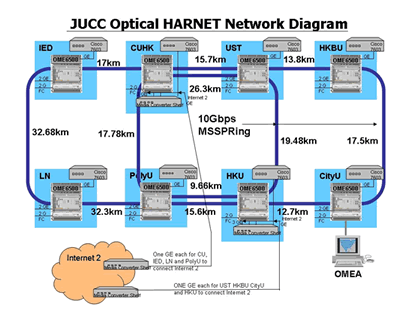Optical HARNET: The next generation networking technology
It is the first time in years the local universities are able to lease dark fibers from a local carrier for setting up the Optical HARNET, an experimental optical network linking up all the HARNET member institutions for collaborative research and academic activities which require high network bandwidth. The optical network was installed and became operational in late August 2006. Previously, dark fibers of the local carriers had been either virtually unavailable or unaffordable to their customers. Currently, most major R&E (Research and Educational) networks worldwide are built using optical circuits based on a mix of TDM (Time-division Multiplexing) and DWDM (Dense Wavelength Division Multiplexing) technologies. With the new Optical network, HARNET is catching up with its counterparts in the Asian Pacific region such as the R&E networks in Mainland China, Taiwan, Japan, Korean and Singapore.
The Optical HARNET will run in parallel with the existing HARNET (which is based on GE circuits provisioned by using the Metro Ethernet service of a local service provider) and will eventually replace it. HARNET member institutions intend to make use of this advanced next generation networking technology for:
-
Providing on-demand high speed network connections to support research and educational applications including Grid computing, multimedia applications, high-resolution videoconferencing, telemedicine applications and network infrastructure research, etc.
-
Supporting inter-institutional collaboration projects like disaster recovery site using remote SAN technology
-
Connecting to other advanced international R&E optical networks
-
Testing native IPv6 and other next generation network technologies
The Optical HARNET consists of 8 nodes, one for each HARNET member. Initially each node is equipped with two GE ports and one 2G Fiber Channel port. One of the GE ports is used to interconnect the HARNET members and the Internet2, while the other GE port and the Fiber Channel port can be used for inter-institutional collaborative projects. The three ports are sharing the same 10G ring using TDM technology. Additional 10G rings can be provisioned by adding a lambda (wavelength) over the same fiber ring using DWDM technology, and a maximum of 72 lambdas can be supported over the same fiber ring. At the moment, DWDM has not been deployed, but another 10G fiber ring is used to connect 4 of the 8 nodes, forming a 4-node inner ring inside the 8-node outer ring. As each 10G ring has an effective bandwidth of 5G due to the fact that half of the bandwidth is reserved for ring protection, the total available bandwidth is 10G for the Optical HARNET. DWDM can be enabled whenever additional bandwidth is required with very little extra cost. As such, unlimited network bandwidth can be made available to HARNET on demand.
